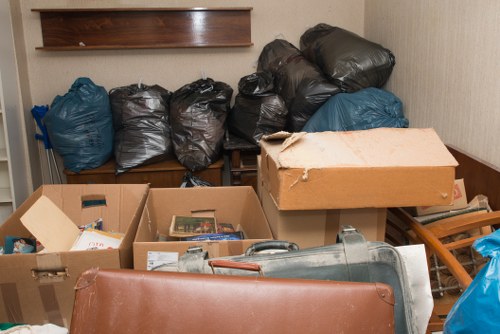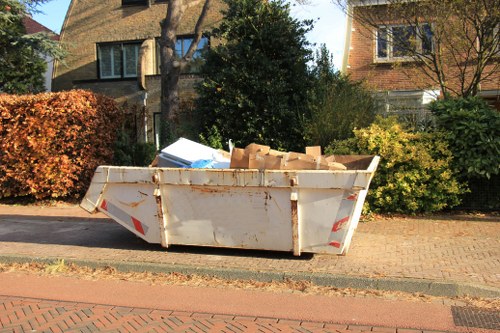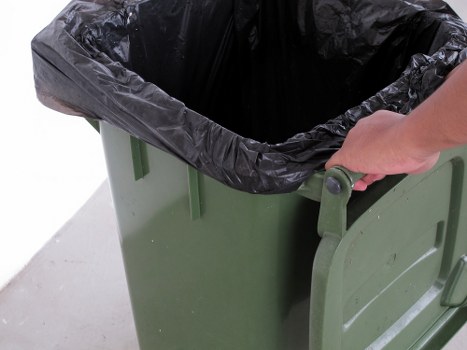House Clearances in Furniture Disposal
Understanding House Clearances

House clearances involve the comprehensive removal of unwanted items from a residence. This process is essential during moving, renovation, or when decluttering to create a more organized living space. Proper house clearance ensures that furniture disposal is handled efficiently, safely, and responsibly.
When it comes to furniture disposal, it is crucial to adopt sustainable practices. Many pieces of furniture can be recycled, donated, or repurposed, reducing the environmental impact associated with waste. Engaging professional house clearance services can aid in navigating the best disposal methods tailored to your specific needs.
Effective house clearances not only free up valuable space but also contribute to a cleaner and healthier living environment. By systematically removing outdated or unnecessary furniture, homeowners can enhance the aesthetic appeal of their homes and improve overall functionality.
Steps Involved in House Clearance

The house clearance process typically involves several key steps to ensure that all items are disposed of appropriately. Initially, a comprehensive assessment of the items to be cleared is conducted to determine the best disposal methods. This assessment helps in categorizing items based on their condition and potential for reuse.
Following the assessment, items eligible for donation or resale are identified and prepared accordingly. Professional clearance services often collaborate with local charities and second-hand stores to facilitate the donation process. This not only aids in reducing waste but also supports community initiatives.
The next step involves the safe and efficient removal of items marked for disposal. This process requires careful handling, especially for bulky or hazardous materials, to prevent damage to the property and ensure the safety of all parties involved.
Furniture Disposal Methods

There are various methods available for disposing of furniture, each with its own set of advantages. Recycling is a popular option, allowing materials to be repurposed and reducing the need for new resources. Many components of furniture, such as wood, metal, and plastic, can be recycled independently.
Donating furniture is another effective disposal method. Items in good condition can be donated to charitable organizations, providing assistance to those in need while promoting sustainability. Additionally, selling furniture through online platforms or garage sales can be a profitable way to dispose of unwanted items.
For furniture that is beyond repair or reuse, professional disposal services ensure that it is handled in an environmentally responsible manner. These services adhere to local regulations and standards, minimizing the ecological footprint of furniture disposal.
Benefits of Professional House Clearance Services

Hiring professional house clearance services offers numerous benefits. Experts in this field possess the necessary skills and equipment to efficiently clear out spaces, saving homeowners time and effort. Their experience ensures that all items are handled with care, reducing the risk of damage during the clearance process.
Moreover, professional services are knowledgeable about local disposal regulations and recycling opportunities. This expertise ensures that furniture disposal is conducted in compliance with environmental standards, promoting sustainability.
Additionally, professional house clearance services provide peace of mind by managing all aspects of the process, from assessment to final disposal. This comprehensive approach allows homeowners to focus on other important tasks, knowing that their clearance needs are in capable hands.
Choosing the Right Furniture Disposal Service

Selecting the appropriate furniture disposal service involves evaluating several factors to ensure that your specific needs are met. It is important to consider the range of services offered, including the ability to handle various types of furniture and the provision of recycling or donation options.
Assessing the reputation and reliability of the service provider is also crucial. Reading reviews, seeking recommendations, and verifying certifications can help in making an informed decision. Additionally, obtaining quotes and comparing pricing structures ensures that the chosen service offers value for money.
Finally, ensuring that the service provider adheres to environmental and safety standards is essential. This commitment not only guarantees responsible disposal but also contributes to the broader goal of sustainability and environmental preservation.
Cost Factors in House Clearances
The cost of house clearances can vary based on several factors. The volume and type of items to be cleared are primary determinants, as larger quantities require more time and resources. Additionally, the complexity of the clearance, such as the need for dismantling furniture or handling hazardous materials, can influence pricing.
Location also plays a role in cost considerations. Services in urban areas may have different pricing structures compared to those in rural regions, reflecting the varying logistical challenges. Furthermore, the urgency of the clearance can affect costs, with expedited services typically commanding higher fees.
Obtaining detailed quotes from multiple service providers and understanding the breakdown of costs can aid in budgeting effectively for house clearances. Transparency in pricing ensures that homeowners are aware of what to expect, avoiding any hidden charges or unexpected expenses.
Environmental Impact of Furniture Disposal
Furniture disposal has significant environmental implications, making it essential to adopt eco-friendly practices. Improper disposal can lead to increased landfill waste, contributing to environmental degradation and resource depletion. By prioritizing recycling, donation, and repurposing, the environmental footprint of furniture disposal can be minimized.
Recycling furniture components reduces the demand for virgin materials, conserving natural resources and lowering energy consumption. Additionally, donating or selling furniture extends its lifecycle, reducing the need for manufacturing new items and promoting a circular economy.
Furthermore, environmentally responsible disposal methods help in reducing greenhouse gas emissions associated with waste processing. By choosing sustainable disposal options, homeowners contribute to broader environmental conservation efforts and promote sustainability within their communities.
Safety Considerations in House Clearances
Safety is a paramount concern during house clearances and furniture disposal. Professional services adhere to safety protocols to prevent accidents and injuries during the removal and transportation of items. This includes the proper handling of bulky or heavy furniture to avoid strain or damage.
Hazardous materials, such as chemicals or sharp objects, require special attention during the disposal process. Experts are trained to manage these items safely, ensuring that they are handled and disposed of in accordance with regulatory standards.
Moreover, maintaining a clutter-free environment during clearances reduces the risk of accidents within the home. Proper organization and systematic removal of items help in maintaining order and preventing potential hazards during the clearance process.
Legal and Regulatory Compliance
Compliance with legal and regulatory standards is essential in house clearances and furniture disposal. Different regions have specific regulations governing the disposal of various materials, including electronics, chemicals, and large furniture items. Adhering to these regulations ensures that disposal is conducted legally and responsibly.
Professional clearance services are well-versed in local laws and guidelines, ensuring that all aspects of the process meet the required standards. This compliance not only avoids potential legal repercussions but also promotes ethical disposal practices.
Additionally, proper documentation and record-keeping are vital, especially for large-scale clearances. Maintaining accurate records ensures accountability and transparency, providing homeowners with assurance that the clearance process is conducted appropriately.
Maximizing Space and Enhancing Home Aesthetics
Effective house clearances can significantly enhance the aesthetics and functionality of a home. By removing excess furniture and clutter, living spaces become more open, inviting, and easier to navigate. This transformation can lead to improved mental well-being and increased comfort within the home.
Strategic furniture disposal allows homeowners to reevaluate their space utilization, ensuring that each piece serves a purpose and contributes to the overall design. This thoughtful approach results in a more harmonious and aesthetically pleasing environment.
Furthermore, decluttering through house clearances can create opportunities for redecorating or renovating, enabling homeowners to refresh their living spaces and adapt to changing needs or preferences.
Sustainable Practices in Furniture Disposal
Embracing sustainable practices in furniture disposal is essential for minimizing environmental impact. This involves prioritizing methods that promote reuse, recycling, and responsible waste management. Sustainable disposal not only conserves resources but also supports environmental conservation efforts.
One effective sustainable practice is upcycling, which involves transforming old furniture into new, functional pieces. This creative approach extends the lifecycle of furniture, reduces waste, and adds unique character to living spaces.
Additionally, choosing eco-friendly disposal services that prioritize sustainability ensures that furniture is handled in a manner that aligns with environmental values. These services often employ green practices, such as using recyclable packaging and minimizing transportation emissions.
Preparing for a House Clearance
Proper preparation is key to a successful house clearance. This involves organizing and categorizing items based on their condition and potential for disposal, donation, or reuse. Creating a detailed inventory helps in streamlining the clearance process and ensures that no items are overlooked.
Homeowners should also plan the logistics of the clearance, including scheduling, access to the property, and any necessary permits or permissions. Clear communication with the clearance service provider is essential to align expectations and ensure a smooth process.
Furthermore, addressing sentimental items with care is important during clearances. Allocating time to evaluate the personal value of certain furniture pieces ensures that meaningful items are preserved while unwanted ones are disposed of responsibly.
Post-Clearance Activities
After completing a house clearance, several post-clearance activities can enhance the overall outcome. This includes deep cleaning the cleared spaces, repairing any damage that may have occurred during the process, and reorganizing the remaining items for optimal functionality.
Homeowners can also take this opportunity to assess their space utilization and consider new furniture or decor that better suits their current needs and preferences. This reflective phase ensures that the clearance leads to a more organized and aesthetically pleasing living environment.
Additionally, evaluating the clearance process can provide valuable insights for future disposals. Identifying areas of improvement and noting successful strategies can aid in making subsequent clearances more efficient and effective.
Frequently Asked Questions (FAQ)
1. What is the typical cost of a house clearance service?
The cost varies based on factors such as the volume of items, complexity of the clearance, and location. Obtaining quotes from multiple providers is recommended to find a service that fits your budget.
2. How can I ensure my furniture is disposed of responsibly?
Choose a professional clearance service that prioritizes recycling, donation, and sustainable disposal methods. Verify their commitment to environmental standards before hiring.
3. What types of furniture can be donated?
Most gently used furniture can be donated, including sofas, tables, chairs, and beds. It's best to check with local charities for their specific donation criteria.
Conclusion
House clearances play a pivotal role in furniture disposal, offering a structured and responsible approach to managing unwanted items. By engaging professional clearance services, homeowners can ensure that their furniture is disposed of efficiently, sustainably, and in compliance with legal standards.
Embracing eco-friendly disposal methods not only benefits the environment but also enhances the living space, contributing to a more organized and aesthetically pleasing home. Proper preparation and selection of the right service provider are essential for a successful house clearance experience.
Take the first step towards a clutter-free home by contacting us today and scheduling your house clearance service. Let our experienced team assist you in creating a more harmonious and functional living environment.